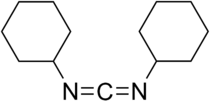N,N-Dicyclohexylcarbodiimide
 | |
 | |
| Names | |
|---|---|
| IUPAC name
N,N'-dicyclohexylcarbodiimide | |
| Other names
DCC | |
| Identifiers | |
| 538-75-0 | |
| ChEBI | CHEBI:53090 |
| ChEMBL | ChEMBL162598 |
| ChemSpider | 10408 |
| |
| Jmol-3D images | Image |
| PubChem | 10868 |
| RTECS number | FF2160000 |
| |
| Properties | |
| Molecular formula |
C13H22N2 |
| Molar mass | 206.33 g·mol−1 |
| Appearance | white crystalline powder |
| Density | 1.325 g/cm3, solid |
| Melting point | 34 °C (93 °F; 307 K) |
| Boiling point | 122 °C (252 °F; 395 K) (at 6 mmHg) |
| not soluble | |
| Hazards | |
| R-phrases | R22 R24 R41 R43 |
| S-phrases | S24 S26 S37/39 S45 |
| NFPA 704 | |
| Flash point | 113 °C (235 °F; 386 K) |
| Related compounds | |
| Related carbodiimides |
DIC,EDC |
| Except where noted otherwise, data is given for materials in their standard state (at 25 °C (77 °F), 100 kPa) | |
| | |
| Infobox references | |
N,N'-Dicyclohexylcarbodiimide is an organic compound with the chemical formula C13H22N2 whose primary use is to couple amino acids during artificial peptide synthesis. Under standard conditions, it exists in the form of white crystals with a heavy, sweet odor. The low melting point of this material allows it to be melted for easy handling. It is highly soluble in dichloromethane, tetrahydrofuran, acetonitrile and dimethylformamide, but insoluble in water. The compound is often abbreviated DCC.
Structure and spectroscopy
The C-N=C=N-C core of carbodiimides (N=C=N) is linear, being related to the structure of allene. Three principal resonance structures describe carbodiimides:
- RN=C=NR ↔ RN+≡C-N−R ↔ RN−-C≡N+R
The N=C=N moiety gives characteristic IR spectroscopic signature at 2117 cm−1.[1] The 15N NMR spectrum shows a characteristic shift of 275.0 ppm upfield of nitric acid and the 13C NMR spectrum features a peak at about 139 ppm downfield from TMS.[2]
Preparation
Of the several syntheses of DCC, Pri-Bara et al. use palladium acetate, iodine, and oxygen to couple cyclohexyl amine and cyclohexyl isocyanide.[3] Yields of up to 67% have been achieved using this route:
- C6H11NC + C6H11NH2 + O2 → (C6H11N)2C + H2O
Tang et al. condense two isocyanates using the catalyst OP(MeNCH2CH2)3N in yields of 92%:[1]
DCC has also been prepared from dicyclohexylurea using a phase transfer catalyst by Jaszay et al. The disubstituted urea, arenesulfonyl chloride, and potassium carbonate react in toluene in the presence of benzyl triethylammonium chloride to give DCC in 50% yield.[4]
Reactions
DCC is a dehydrating agent for the preparation of amides, ketones, nitriles. In these reactions, DCC hydrates to form dicyclohexylurea (DCU), a compound that is insoluble in most organic solvents and in water and hence is readily removed by filtration. DCC can also be used to invert secondary alcohols.
Moffatt oxidation
A solution of DCC and dimethyl sulfoxide (DMSO) effects the so-called Pfitzner-Moffatt oxidation. This procedure is used for the oxidation of alcohols to aldehydes and ketones. Unlike metal-mediated oxidations, the reaction conditions are sufficiently mild to avoid over-oxidation of aldehydes to carboxylic acids. Generally, three equivalents of DCC and 0.5 equivalent of proton source in DMSO are allowed to react overnight at room temperature. The reaction is quenched with acid.
Dehydration
Alcohols can also be dehydrated using DCC. This reaction proceeds by first giving the O-acylurea intermediate which is then hydrogenolyzed to produce the corresponding alkene:
- RCHOHCH2R' + (C6H11N)2C → RCH=CHR' + (C6H11NH)2CO
Inversion of secondary alcohols
Secondary alcohols can be stereochemically inverted by formation of a formyl ester followed by saponification. The secondary alcohol is mixed directly with DCC, formic acid, and a strong base such as sodium methoxide.
Esterification
A range of alcohols, including even some tertiary alcohols, can be esterified using a carboxylic acid in the presence of DCC and a catalytic amount of DMAP.[5]
DCC-promoted peptide coupling
During protein synthesis (such as Fmoc solid-state synthesizers), the N-terminus is often used as the attachment site on which the amino acid monomers are added. To enhance the electrophilicity of carboxylate group, the negatively charged oxygen must first be "activated" into a better leaving group. DCC is used for this purpose. The negatively charged oxygen will act as a nucleophile, attacking the central carbon in DCC. DCC is temporarily attached to the former carboxylate group forming a highly electrophilic intermediate, making nucleophilic attack by the terminal amino group on the growing peptide more efficient.
Safety
DCC is a potent allergen and a sensitizer, often causing skin rashes.
See also
References
- ↑ 1.0 1.1 Tang, J.; Mohan, T.; Verkade, J. G. (1994). "Selective and Efficient Syntheses of Perhydro-1,3,5-triazine-2,4,6-triones and Carbodiimides from Isocyanates Using ZP(MeNCH2CH2)3N Catalysts". Journal of Organic Chemistry 59 (17): 4931–4938. doi:10.1021/jo00096a041.
- ↑ Yavari, I.; Roberts, J. D. (1978). "Nitrogen-15 Nuclear Magnetic Resonance Spectroscopy. Carbodiimides". Journal of Organic Chemistry 43 (25): 4689–4690. doi:10.1021/jo00419a001.
- ↑ Pri-Bar, I.; Schwartz, J. (1997). "N,N-Dialkylcarbodiimide Synthesis by Palladium-Catalysed Coupling of Amines with Isonitriles". Chemical Communications 1997 (4): 347–348. doi:10.1039/a606012i.
- ↑ Jászay, Z. M.; Petneházy, I.; Töke, L.; Szajáni, B. (1987). "Preparation of Carbodiimides Using Phase-Transfer Catalysis". Synthesis 1987 (5): 520–523. doi:10.1055/s-1987-27992.
- ↑ Neises, B.; Steglich, W. (1985). "Esterification of Carboxylic Acids with Dicyclohexylcarbodiimide/4-Dimethylaminopyridine: Tert-Butyl Ethyl Fumarate". Org. Synth. 63: 183.; Coll. Vol. 7, p. 93


